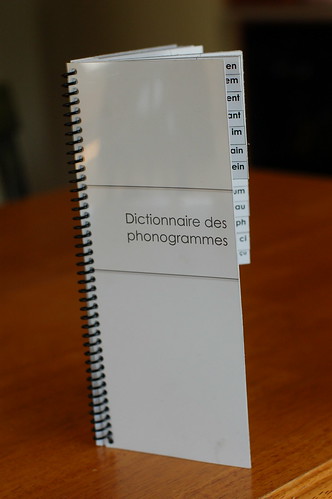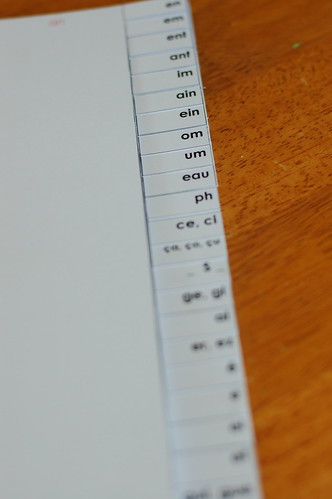Showing posts with label ressources françaises. Show all posts
Showing posts with label ressources françaises. Show all posts
Thursday, 28 June 2012
phonogram dictionary - Le dictionnaire des phonogrammes
The language part of Montessori is hard for me. The reason is simple, information about Montessori in french are scarce, and translation is not as much as an option as for maths for instance. There are so many difficulties in the french language, it is a world of it's own.
So needless to say that finding a Montessori album in french has proven difficult to do. But with luck, good connections, and perseverance, I finally did. I was anxious to see what were the methods used in french to teach the art of language.
I knew already that the pink, blue and green scheme is not the widely taught method in the French AMI formation. I had seen a lot about " les dictées muettes" which are used a one branch of Montessori (Montessori de St-Nicolas) but this is not what AMI teachers use around here, they use the Murielle Dwyer scheme.
I first came across this scheme while reading What did we do all day. In fact, MBT had recommended me the pamphlet made by NAMTA about language before I found my album; it explains quite extensively this method. It already made sense to me at that point. In fact, I liked this scheme better then the pink-blue-green that I kept reading about and that seemed to complicated to me.
It is not my intention to talk extensively about this scheme, as others have done it already. But I want to talk about one specific part of it.
This method suggest the use of a phonogram dictionary, which I thought was genius. Not having seen on in french yet on the web, I thought I'd put mine up.
I printed it on heavy card type card stock, and had it binder with a black spiral. The first and last pages are protected by a transparent plastic.
first page:
these are the key phonograms that I wanted to have in there. I copied what I had, but looking back, there are 1 or 2 changes that I would have made. (including removing the ill in the key phonograms)
then the following pages are the different graphemes with the sound they make. Si let's say the child gets stuck while reading on a combinaison of letters he is not able to sound, he just goes to the page of this grapheme, and reads the sound this particular combo of letter makes. In this case, the child would have read something that contained "en", and turning to the right page, he would have know that this sounds like "an" which is a phoneme that is learned with the sandpaper letter, a key one.
I think the biggest challenge in making this was to have all the phonograms fit on one page.
X loves it, and has been using it a lot while reading. So far so good.
Si vous faites Montessori à la maison, et que vous n'avez pas suivit de formation, vous connaissez autant que moi la difficulté à se procurer du matériel Montessori en français. J'ai cherché tant bien que mal un album de langue en français, et j'ai bien faillit me découragée quand finalement, j'ai réussi à en trouver un de par les contacts que j'ai dans le milieu des écoles Montessori.
Par contre, avant de réussir à mettre la main sur cet albums, j'avais fait beaucoup de recherches sur la méthode de langue tant en anglais qu'en français. Il me semblait claire que les boites rose, bleues et vertes n'étaient pas la norme, en tout cas pas ici, et que les dictées muettes étaient un façon bien connu dans certains endroits de la France, mais pas ici. J'avais alors tournée mon choix vers la méthode de Muriel Dwyer, une méthode toute simple, et qui fonctionne pour toutes les langues. J'ai donc acheté. son fascicule chez NAMTA, et après en avoir fait la lecture, j'ai commencé le travail de "traduction".
Par chance, l'album de langage que j'ai reçu utilise cette même méthode. Je crois que les formation AMI ici prônent l'utilisation de cette façon de faire. Après lecture extensive, je peux confirmer que c'est la méthode qui a été utilisé par mes enfant dans leur école Montessori locale. (qui est dirigée par une directrice AMI)
L'objectif de ce billet n'est pas de vous expliquer en détail cette méthode. Si vous lisez l'anglais, et que vous désirez en connaître plus sur celle-cil je vous recommande chaudement le fascicule mentionné plus haut: A path for the exploration of any language leading to reading and writing" chez NAMTA.
Cette méthode suggère l'utilisation d'un dictionnaire des phonogramme pour l'enfant qui lit déjà, mais qui a encore besoin d'un coup de pouce pour les divers phonèmes et les sons que ceux ci font. Je trouvais l'idée géniale, et voyait complètement l'utilité de la chose pour X.
J'ai donc fabriqué, en répliquant le dictionnaire de l'album, mon propre dictionnaire des phonogrammes.
J'ai imprimé les pages sur du cartons à cartes de souhait, fait relié le tout avec une spirale, et ai ajouté des plastique devant et derrière pour protéger les pages.
À la première page, j'ai mis les phonèmes clés. Si c'était à refaire, je ferai 1 ou 2 modifications et je ne referait pas si fidèlement le dictionnaire. J'enlèverai, entre autre le ill à cette première page, et je rajouterai le "f" et le "Y"
Les pages suivante sont les différents graphèmes que l'enfant peut recentrer durant la lecture. Si l'enfant ne sais pas lire "en" il se rend à la page identifié par le graphème, et lit le phonème correspondant, dans ce cas, "an". Les phonèmes clé sont appris par l'utilisation des lettre rugueuse vertes.
X adore le dictionnaire, et l'utilise régulièrement lors de ses lectures.
Sunday, 15 January 2012
the power of music - part 2
You can find part one here
******************************
So today, I want to share with your our current choices and all time favourites when it comes to music for our children. THey are not only disc made especially for children.
Keep in mind that these are our current choices, choices that are evolving through time, as our children grow. This list will probably be completely different in a year, it would be fun to visit it then.
So without further ado:
Music for sleeping and relaxation:
X's choice for bedtime:
M's choice for bedtime:

Our current choice for E:
Other favorite choices:
Sleep baby (found on itunes)
Best nature sounds ( I cannot seem to find the exact one sorry)
Calm day music
The nutcracker: Can't find the exact album we own
I THINK it is this one
Music for children / folkloric music IN FRENCH
La bonne chanson: pour les enfants (sample here)
Music of the world
Traditional music
These choices by Michael Olaf are our next tries
Jazz
Discs to learn:
 |
| also available in english |
 |
| And all the other ones in the series... |
This next series is in french
X loves this one and plays it often in his room:
And they adore this remake of a Beatle song by Los Manolos!! Dancing guaranteed!
Los Manolos
Another absolute favourite is Iz's somewhere over a rainbow
The Beatles seems to be the flavor of the month. Will probably change eventually...
I'll add to this list as time go by, and when new favourites are found.
Subscribe to:
Posts (Atom)

















































